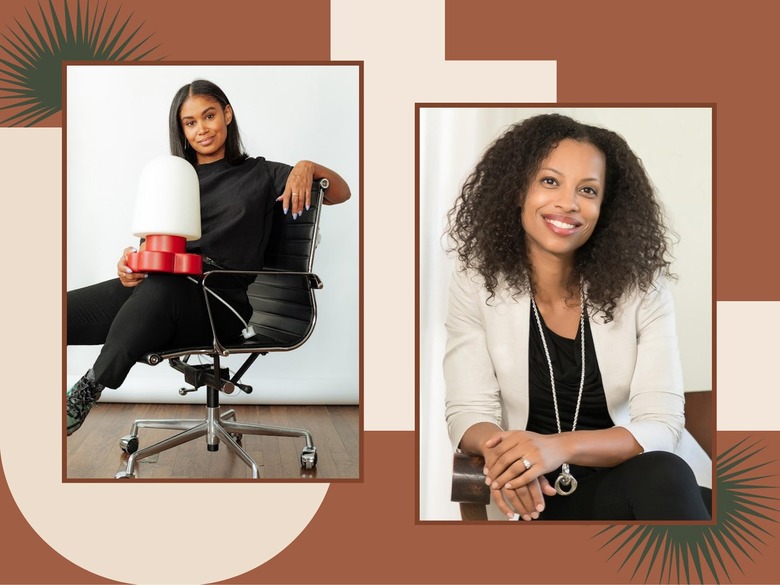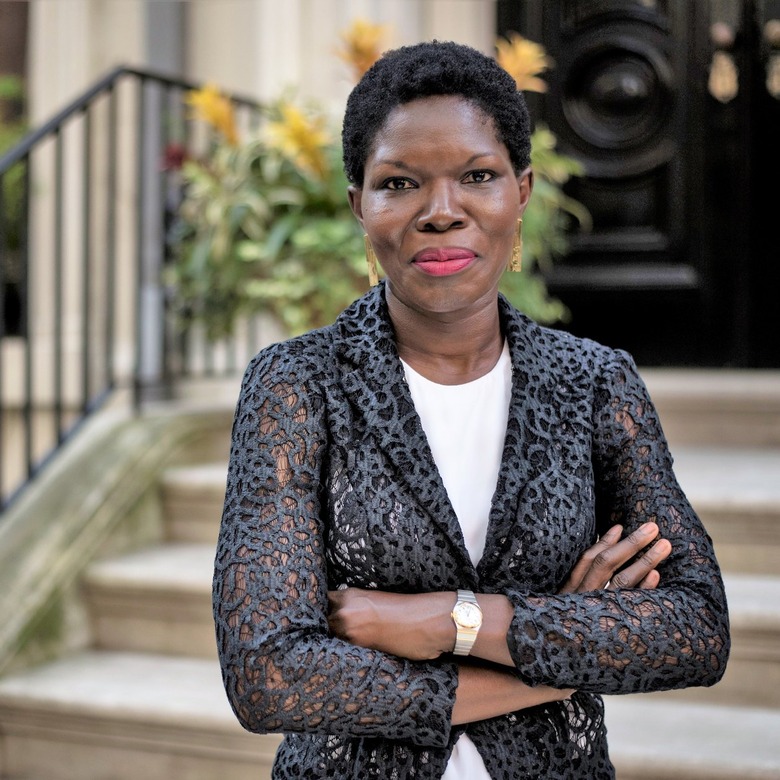Black Home Design Business Owners On Highs, Lows, And How They Got Their Start
In addition to being the last full month of summer, August is also National Black Business Month, a time to celebrate and honor the history of Black enterprises, both past and present. Created in 2004 by historian John William Templeton and engineer Frederick E. Jordan, National Black Business Month highlights companies across the U.S. while also advocating against the structural barriers faced by Black entrepreneurs.
Templeton previously edited Freedom's Journal, the oldest Black newspaper in the U.S., and Jordan runs an engineering/construction company. The concept for National Black Business Month was inspired by Templeton and Jordan's own personal experiences starting and sustaining businesses, coupled with an acknowledgement that, although things have improved, there is still plenty of room for change and growth.
Earlier this year, Zippa, a job search company, released a report that only 2% of interior designers in the U.S. are Black or Black American. Though that number tells a predictable and upsetting story about the design industry's reception to and support of Black designers, it doesn't capture the enormous breadth of Black culture's influence on design in general, as both creatives and consumers.
There are so many stories to engage with and learn from, and National Black Business Month allows for another opportunity to expand the narratives around what entrepreneurship can and should look like in the design space. To that end, we spoke with five decor and design business owners to hear more about their journeys starting a brand in this space. Most pivoted to design after years spent on a completely different career path.
Laura Hodges of Laura Hodges Studio and Domain
Laura Hodges — the interior designer and owner of Washington D.C. design firm Laura Hodges Studio and the sustainable, fair-trade home decor shop Domain — decided to pursue interior design after receiving a promotion at her marketing job.
"I just felt like I wanted to try something more creative," Hodges tells Hunker. "I'd always had an interest in interior design and architecture, but I just didn't know the full extent of the industry, so that's why I chose to go back to school to earn my degree." Once she enrolled at the New York School of Interior Design, the creator "fell in love with design and knew [she'd] found the right fit for [her] career."
Ariene Bethea of Dressing Rooms Interior Studio
For Ariene Bethea, interior designer and owner of vintage decor shop and design studio Dressing Rooms Interior Studio, the path to being a business owner "wasn't a straight line." Trained in corporate communication, she worked in human resources for years before experiencing her "aha moment," as she calls it (by way of Oprah Winfrey), after redesigning her boss's cramped office space.
"I worked at a university at the time, so we had skills trades [employees who did any and all trade work needed] on campus. I had them build some custom shelving for [my boss's] office," she says. "I changed out the floor plan and she came back and was like, 'Oh my god, this makes so much more sense. You should do this for a living.'"
Dressing Room Interiors began as a blog before shifting into an Etsy shop, which was stocked with items Bethea purchased from estate sales and auctions. When Bethea had a job in HR, she worked on her business during her free time, in the evenings and on weekends. When she eventually lost her HR job in 2011, she decided to turn her passion project into her main focus.
Leaning on her corporate background, Bethea made sure to implement performance reviews to keep on track. "My plan was to start selling online and do some pop-up shops, which were very new at the time, move into a multi-merchant space, and then open my shop," she says. "Now that was a straight line. That's exactly how it ended up happening." She opened her first brick-and-mortar store in 2015 in Charlotte, North Carolina.
Shannon Maldonado of YOWIE
Shannon Maldonado, founder of YOWIE, a creative platform, storefront, and design studio based in Philadelphia, understands the nuances of turning a side hustle into a full-time job. Prior to starting YOWIE, she worked as a fashion designer for legacy brands like Tommy Hilfiger, Ralph Lauren, and American Eagle.
"When I decided in late 2015 that I wanted to leave [my career] and start my business, of course there was a lot of fear," she explains. However, her previous career ultimately provided a scaffolding for her new venture: "I ended up cashing some of my stocks from AE [American Eagle] to start the brand, a kind of nest egg to pull it together."
Maldonado also moved into a smaller, more affordable apartment in order to cut costs, since she "didn't have a never-ending savings [account] to pull from." She had to get inventive in other areas, too, reaching out to her community of artists to help with website design, photoshoots, and more. These choices took some pressure off Maldonado, giving her the flexibility that would have been impossible to achieve if she opened the store in New York City.
"I wanted to be able to make mistakes and not feel like they could take us down, say, if our rent was $10,000 or $15,000 a month," Maldonado says. "That's a lot of pressure on a really small brand out the gate."
Jeanine Hays and Bryan Mason of AphroChic
Besides a love for design, some entrepreneurs discussed other intentions for starting their brand. In 2006, husband-and-wife team Jeanine Hays and Bryan Mason created a blog called AphroChic to reflect what they wanted to see in the design space.
"There were tons of home decor blogs focused on a white lens on design, but none that celebrated Black contributions," Mason explains. "AphroChic was born out of a necessity to showcase the myriad contributions of Black designers."
Sixteen years later, AphroChic is a multifaceted company, working across interior design, home goods, and print publications. "There's a lot of scholarship in our brand," Hays reveals. This reflects the couple's respective backgrounds in law and African Diaspora studies. For them, design is a "cultural artifact" and an act of storytelling, one that preserves cultural and familial history.
"Black spaces tell a story. They are about more than fancy furniture or name brand pieces. Our homes have a soul to them, filled with inherited pieces, items that help express Black identity," Mason says.
Nana Quagraine of 54kibo
Nana Quagraine echoes the desire to fill in gaps in the industry, extending it to her business philosophy: "You're solving a problem. If you don't solve someone's problem, they're not buying whatever you're selling."
A former investment banker who used to split her time between Brooklyn and Johannesburg, South Africa, Quagraine was curious why different types of African design weren't more accessible in the U.S. She was also frustrated by the U.S. design industry's habit of marketing any and all African design as "ethnic" or "tribal," which masked a deeper unwillingness to acknowledge and explore the innumerable creative expressions within the 54 countries comprising Africa, as well as numerous diasporic communities across the globe.
The birth of her twins in 2018 motivated Quagraine to take a leap and leave her high-octane career to launch her own business. 54kibo was born. Within the online home decor retail store dedicated to contemporary African design, Quagraine works with a continental team to offer handmade items by local artisans, like the rope ceiling pendant lights made with wooden rings. "Year one was, 'How do I set up this business?'" she explains. "Now it's, 'How do I organize my conversion rate? Who's the specialist I need to speak to? How do we tell these stories better?'"
When it comes to getting the word out about your business, many cite the rise of social media as a positive force. Although some, like Bethea, lament the decline of print shelter (aka home design) magazines, she's excited by how the digital realm has allowed designers and business owners to have more control over their marketing and visibility.
"Designers don't have to really rely on magazines as much as they used to because of Instagram," Bethea says. "You can reach your audience, reach all the eyeballs, and still get clients through social media."
Maldonado took that approach to heart when thinking of ways to get the word out about YOWIE. She often relates the story of cold emailing "over 150 people to invite them to [her] first pop-up." The move was a risk, and forced her out of her comfort zone as an introvert, but, in the end, it turned out to be a wild success. Events like these infused YOWIE with the intimate energy the brand is now celebrated for.
The past two years have been a time of enormous uncertainty in the design industry (and the world at large) due to the COVID-19 pandemic. Though the pandemic forced closures and upended lives, certain aspects of the design industry thrived. Since people were spending more time at home, there was a need to spruce up their spaces to accommodate new live/school/work environments.
Hodges remarks that "[t]he pandemic reminded everyone how important our homes can be." All the designers mention experiencing an uptick in orders and clients. For some, like Quagraine, whose business operated remotely since launching in 2018, the pandemic did not disrupt much: "What shifted was that our prospective customer was more comfortable buying online."
Still, those with brick-and-mortar spaces had to adjust in other ways. "The pandemic has had a devastating effect on businesses across the board, but as in so many things, its impact on Black businesses was especially hard," Hays notes, stressing the importance of initiatives to help businesses "rebound and grow."
What changes have there been in the design space? Hays notes that she saw the most change occur over the last two years. She points to the massive Black Lives Matters protests in 2020, and how that triggered a shift in the way the design media covers BIPOC designers. Other designers, like Bethea and Maldonado, also point to the impact of the protests and how they forced the design industry to take a deeper look at its own history of racism and exclusion. However, they hope that the commitment to change is ongoing and structural, and not just a passing trend.
"We need more Black teachers at design schools," says Hays. "More Black editors and writers at mainstream magazines to help reshape what is still a very Eurocentric design narrative."
AphroChic demonstrates what inclusive design media could look like through their lifestyle magazine, which could be seen as their take on a shelter magazine, one whose perspective is informed and inspired by the rich history of African Diasporic culture and design.
Although operating in a different manner, 54kibo shares a similar philosophy as Hays, Mason, and the other designers mentioned. Through her company, Quagraine believes "we're expanding the visual imagery," using design and home decor to tell stories that resonate on a personal and universal level.









